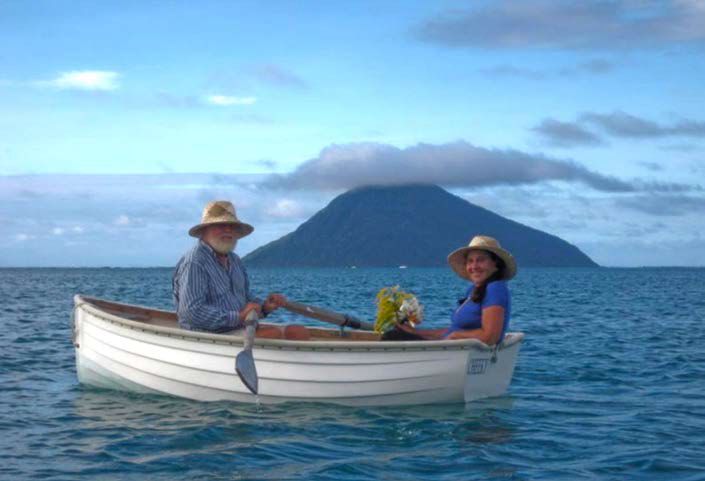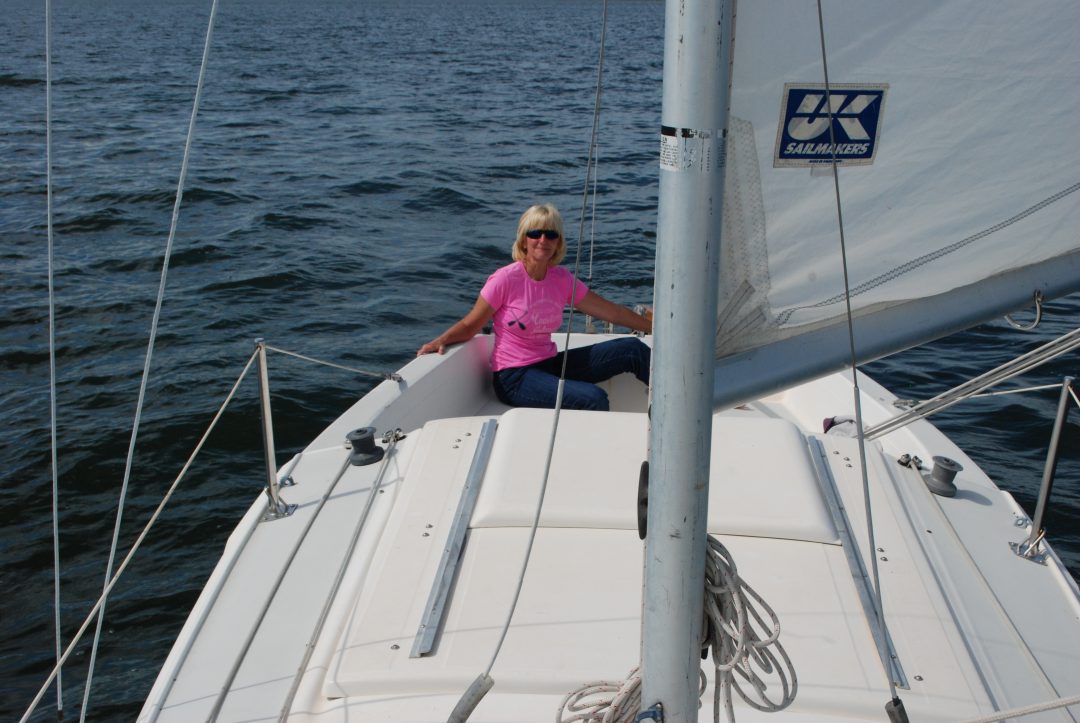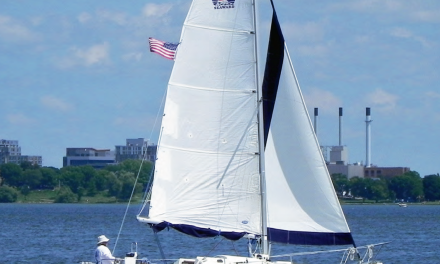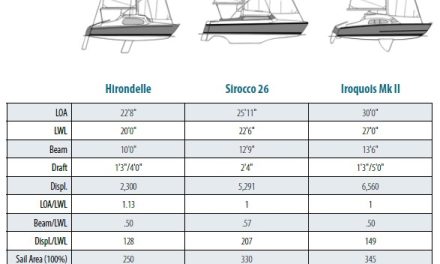The little boat that could
Issue 155: March/April 2024
In an era of increasingly bigger boats, sometimes it’s the smaller vessels that steal the show — like our beloved Fatty Knees 8 dinghy. Despite its modest size and funny name, this dinghy has earned a well-deserved cult following, thanks to its smart design.
The Fatty Knees 8 dinghy, often referred to simply as the “Fatty Knees” or “Fatty,” was designed by renowned naval architect Lyle Hess for celebrated sailing legends Lin and Larry Pardey. “We wanted something that would be a good cargo-carrying boat,” Lin told me over the phone. “The limitation was that it had to fit under the boom, be 8 feet long and as light as possible, but strong.”

Lin and Larry Pardey aboard their beloved Fatty Knees 8, Cheeky.
Hess, who also designed both of the Pardeys’ Bristol Channel Cutters, was up for the task. He decided to use the classic fishing wherry boats as inspiration, since they were designed to carry weight and allow the rower to sit in multiple locations to compensate for the displacement, which is how the Fatty Knees got its notable T-shaped seat.
The Fatty Knees’ range of capabilities, paired with the Pardey stamp of approval, are what make this fantastic little dinghy one of the most versatile small boats you can find.
A Sturdy Tender
Made from robust fiberglass, the Fatty Knees is built to withstand the rigors of life as a tender. It can handle the daily challenges of ferrying passengers and supplies between the shore and your larger boat, but also arguably can be repaired easier than an inflatable tender.
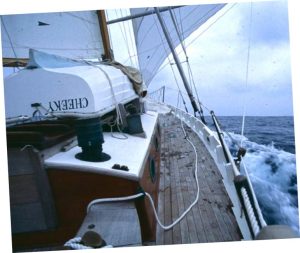
Cheeky safely stowed aboard Lin and Larry Pardey’s Taleisin.
“One day when we were anchored by one of the South Pacific islands, Larry went ashore to get water and he came back with a hole in the dinghy after having a run-in with a coral head,” Lin recalled. That evening, they hoisted Cheeky, their Fatty Knees, aboard and got to work fiberglassing the hole. Cheeky was back in service once the resin had cured, continued to be used heavily by the Pardeys during their 15 years cruising aboard Taleisin, and is still in use by Taleisin’s new crew some 35 years later.
While visiting Cabo San Lucas, Mexico, my partner, Chris, and I needed to ferry around 300 pounds of extra cargo — diesel, provisions, boat parts, and more — from the shore to our boat, which was anchored about a mile away. The Fatty Knees’ lapstrake construction, known for its strength and stability, allowed us to carry the extra weight without compromising performance. As we ventured through the harbor channel, encountering a 3-foot chop, our little boat powered over the waves, leaving onlookers in awe. Unlike some of the struggling inflatables attempting the same course, we stayed dry, thanks to the high freeboard. And that’s when it hit us — yet another “I love this boat” moment.
The stability of the Fatty Knees is what inspired Lin to bestow ours with the name Winglet when we asked her to choose a moniker. In an email, she explained that the name was inspired by our current boat, Avocet, and our previous dinghy, Little Wing. “I also think of the stability and efficiency of the little Fatty Knees dinghies,” she wrote, “and this reminds me of the reason winglets have now been added to jet airplane wings to improve both stability and efficiency, and save energy. Quite fitting for a Fatty Knees, I think.” And so our dinghy became known as Winglet.
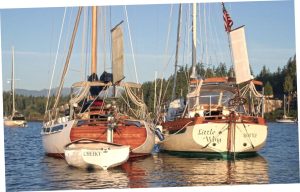
The Pardeys’ Taleisin and Cheeky, rafted alongside a fellow Bristol Channel Cutter.
Propulsion Options
Although the Fatty has a well-balanced design that makes it easy to row, it has other propulsion options. With a sail kit and daggerboard, this little dinghy can be transformed into one of the most fun little sailing boats to cruise around anchorages, harbors, and other areas. Chris and I can both fit comfortably aboard while sailing but have also squeezed another person in, still leaving us with a decent amount of freeboard.
“I can’t count the number of times we invited local youngsters (and often not so young folks) to share a sail on little Cheeky,” Lin said. “I often recall the time when a cruising mother asked if she could borrow the dinghy for a few hours. When she came sailing back, she sighed and said, ‘What bliss, a chance to get some real peace and tranquility and feel like I was playing at the same time.’”
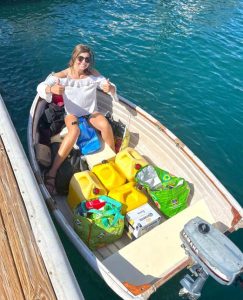
Winglet loaded with diesel and provisions in Cabo San Lucas, Mexico.
Although Chris and I have had the pleasure of sailing our Winglet through many anchorages, sailing is our least used mode of propulsion. Instead, we primarily use our 2-hp outboard to get us safely to and from shore, and although many may argue it is slow, I like to counter with a simple question: “What’s the rush?”
Whether you choose to row, sail, or motor the Fatty Knees, you will find that the boat handles phenomenally.

Winglet and Walnut ghosting along on an evening cruise.
Seamless and Simple
Beyond merely captivating with its visual allure, the Fatty Knees 8 embodies practicality. Its size allows for effortless handling on and off the water, while the robust fusion of fiberglass and marine plywood guarantees longevity. A sound investment, this dinghy is a reliable and enduring choice for sailing enthusiasts, standing resilient against the test of time.
“I acknowledge the merits of an inflatable tender, but I genuinely miss the simplicity of a hard sailing dinghy, reminiscent of my days cruising on Taleisin,” Lin said. “Easy to row, enduring, and a joy to sail. Besides, seals can’t puncture it, like what happened to a friend’s inflatable at South Georgia Island.”
She reflected for a moment, then added, “If there was room for it onboard Sahula (the boat she currently cruises on), it would be here.” Lin’s Cheeky (the 3rd) remains a cherished possession, utilized during her time at home in New Zealand.

The author’s partner, Chris, rowing their Fatty Knees 8 in San Francisco’s Aquatic Cove.
While the Fatty Knees 8 dinghy may boast modest dimensions, it stands as a giant in terms of versatility, durability, and classic charm. With its multifaceted uses, modern features, and enduring design, it’s no surprise that sailors and other boating enthusiasts hold this petite vessel in high esteem. Whether navigating bustling harbors or savoring the thrill of wind in your sails, the Fatty Knees dinghy unquestionably earns its place as a sailing classic in its own league.
My partner, Chris, and I were captivated by this tender long before we became the proud owners of our 1979 Cheoy Lee 41, Avocet. We’re delighted to possess a piece of sailing history that continues to prove its worth on all our cruising adventures and to demonstrate that bigger and faster is not always better. Sometimes the finest things in life come in capable and compact packages.

Larry Pardey proving how capable the Fatty Knees 8 is for hauling cargo.
Marissa and her partner, Chris, have lived aboard their 1979 Cheoy Lee, 41 Avocet, for five years and have been cruising since 2022. Read about their refit or follow their journey on YouTube (Sailing Avocet) or their blog at svavocet.com. Follow Lin Pardey on Instagram @pardeylin.
Thank you to Sailrite Enterprises, Inc., for providing free access to back issues of Good Old Boat through intellectual property rights. Sailrite.com

